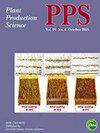水稻库容估算——基于千粒重和投影面积计算方法的比较
IF 1.3
3区 农林科学
Q2 AGRONOMY
引用次数: 0
摘要
水稻库容量的精确估计(粒数 × 潜在晶粒尺寸),独立于晶粒填充,对于考虑源-汇相互作用是必要的。然而,如何测量潜在的晶粒尺寸仍然是一个有争议的问题。在这里,我们使用具有较大小穗数的粳稻品种Koshihikari及其近等基因系,研究了改变灌浆环境对通过比重或糙米厚度、谷粒投影面积(“谷粒面积”)或谷壳重量作为潜在粒径候选指标筛选的1000粒重的影响。我们发现谷物面积最好,其次是1000粒重。我们开发了一种从粮食面积计算水槽容量的新方法;该方法是根据个体粒重与粒面积之间的关系发展起来的。与传统的基于1000粒重的方法相比,基于粒面积的方法虽然更准确,但基于1000粒重量的方法足够有用,因为通过比重或糙米厚度筛选可以很好地选择灌浆颗粒,并且灌浆环境对1000粒重影响有限。图形摘要本文章由计算机程序翻译,如有差异,请以英文原文为准。
Estimation of sink capacity of rice grains: A comparison of calculation methods based on 1000-grain weight and grain projected area
ABSTRACT Accurate estimation of sink capacity in rice (grain number × potential grain size), independent of grain filling, is necessary for considering source – sink interactions. However, how to measure potential grain size is still a matter of debate. Here, we investigated the effect of modifying the grain-filling environment on 1000-grain weight of grains screened by specific gravity or brown rice thickness, grain projected area (‘grain area’), or husk weight as candidate indicators of potential grain size using a japonica cultivar Koshihikari and its near-isogenic line with greater spikelet number. We found grain area to be the best, followed by 1000-grain weight. We developed a novel method to calculate sink capacity from grain area; the method was developed based on the relationship between individual grain weight and grain area. Comparison with the conventional method based on 1000-grain weight showed that although the method based on grain area is more accurate, that based on 1000-grain weight is useful enough, because screening by specific gravity or brown rice thickness selected filled grains well, and the effect of the grain-filling environment on 1000-grain weight was limited. GRAPHICAL ABSTRACT
求助全文
通过发布文献求助,成功后即可免费获取论文全文。
去求助
来源期刊

Plant Production Science
农林科学-农艺学
CiteScore
5.10
自引率
4.00%
发文量
27
审稿时长
>36 weeks
期刊介绍:
Plant Production Science publishes original research reports on field crops and resource plants, their production and related subjects, covering a wide range of sciences; physiology, biotechnology, morphology, ecology, cropping system, production technology and post harvest management. Studies on plant production with special attention to resource management and the environment are also welcome. Field surveys on cropping or farming system are also accepted. Articles with a background in other research areas such as soil science, meteorology, biometry, product process and plant protection will be accepted as long as they are significantly related to plant production.
 求助内容:
求助内容: 应助结果提醒方式:
应助结果提醒方式:


